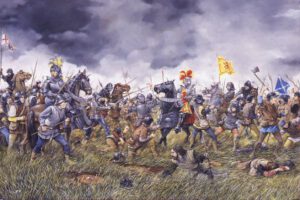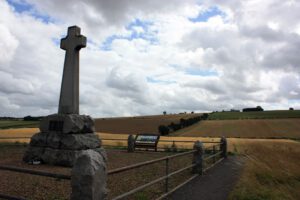The Battle of Flodden Field
September 1513
Prehistory
As a member of the ‘Holy League’ England fought on the Side of the Swiss, Spaniards, the roman-german Emperor Maximilian I. and Pope Julius II. against France. Although Scotland was not directly involved in the Dispute, but was according to the ‘Auld Alliance’ an allied France.
The Conflict began when James IV. took advantage of Henry VIII’s absence and declared War on England.
The Battle
After days of maneuvering, the English, led by Thomas Howard, Earl of Surrey, managed to cross the Till River and get behind the scottish Lines.

The scottish Gunners opened the fire, but due to inadequate Training and damp Gunpowder they mostly missed their Target, while the more experienced english Artillery proved deadly accuracy.
When the scottish Gunners were driven out, the fires of english Cannons and Archers focused on the Pikemen, and the Scots began to storm down the Hill to escape their Reach. The english Halberdiers, however, had little trouble against the scottish Spears. In the Battle, the Scots were defeated, the scottish King, many Nobles and far more than 10,000 Soldiers killed.
Consequences

The Battle was catastrophic for the Scots and went down in History as ‘Slaughter of the Flowers of the Forest’ and was a to high Price for the Friendship with France. Henry VIII. appointed Howard to the Duke of Norfolk and the Baron of Monteagle, Edward Stanley to Knight of the Order of the Garter.
The scottish Dead´s were commemorated the Bagpipe Song ‘Flowers often the Forest’:
We’ll here nae mair lilting at our ewe milking,
Women and bairns are heartless and wae,
Sighing and moaning on a ilka green loaning,
The flooers o’ the forest are a wede away.